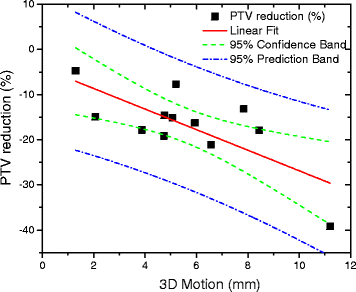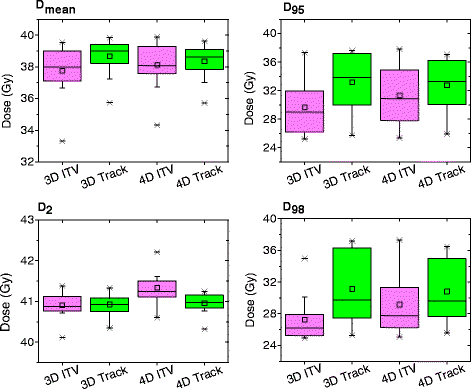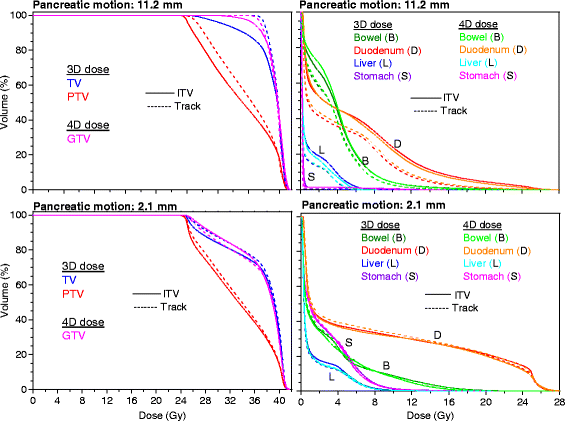Potential dosimetric benefits of adaptive tumor tracking over the internal target volume concept for stereotactic body radiation therapy of pancreatic cancer
- PMID: 29121945
- PMCID: PMC5680781
- DOI: 10.1186/s13014-017-0906-9
Potential dosimetric benefits of adaptive tumor tracking over the internal target volume concept for stereotactic body radiation therapy of pancreatic cancer
Abstract
Background: Radiotherapy for pancreatic cancer has two major challenges: (I) the tumor is adjacent to several critical organs and, (II) the mobility of both, the tumor and its surrounding organs at risk (OARs). A treatment planning study simulating stereotactic body radiation therapy (SBRT) for pancreatic tumors with both the internal target volume (ITV) concept and the tumor tracking approach was performed. The two respiratory motion-management techniques were compared in terms of doses to the target volume and organs at risk.
Methods and materials: Two volumetric-modulated arc therapy (VMAT) treatment plans (5 × 5 Gy) were created for each of the 12 previously treated pancreatic cancer patients, one using the ITV concept and one the tumor tracking approach. To better evaluate the overall dose delivered to the moving tumor volume, 4D dose calculations were performed on four-dimensional computed tomography (4DCT) scans. The resulting planning target volume (PTV) size for each technique was analyzed. Target and OAR dose parameters were reported and analyzed for both 3D and 4D dose calculation.
Results: Tumor motion ranged from 1.3 to 11.2 mm. Tracking led to a reduction of PTV size (max. 39.2%) accompanied with significant better tumor coverage (p<0.05, paired Wilcoxon signed rank test) both in 3D and 4D dose calculations and improved organ at risk sparing. Especially for duodenum, stomach and liver, the mean dose was significantly reduced (p<0.05) with tracking for 3D and 4D dose calculations.
Conclusions: By using an adaptive tumor tracking approach for respiratory-induced pancreatic motion management, a significant reduction in PTV size can be achieved, which subsequently facilitates treatment planning, and improves organ dose sparing. The dosimetric benefit of tumor tracking is organ and patient-specific.
Keywords: Motion management; Pancreas; Radiotherapy; Stereotactic body radiation therapy; Tumor tracking.
Conflict of interest statement
Ethics approval and consent to participate
For this study anonymized patient data was used. According to our local ethics committee this does not require ethics approval.
Consent for publication
Not applicable.
Competing interests
The authors declare that they have no competing interests.
Publisher’s Note
Springer Nature remains neutral with regard to jurisdictional claims in published maps and institutional affiliations.
Figures



Similar articles
-
Assessment of Monte Carlo algorithm for compliance with RTOG 0915 dosimetric criteria in peripheral lung cancer patients treated with stereotactic body radiotherapy.J Appl Clin Med Phys. 2016 May 8;17(3):277-293. doi: 10.1120/jacmp.v17i3.6077. J Appl Clin Med Phys. 2016. PMID: 27167284 Free PMC article.
-
Three-dimensional versus four-dimensional dose calculation for volumetric modulated arc therapy of hypofractionated treatments.Z Med Phys. 2016 Mar;26(1):45-53. doi: 10.1016/j.zemedi.2015.06.010. Epub 2015 Jul 14. Z Med Phys. 2016. PMID: 26187810
-
Dosimetric analysis of stereotactic rotational versus static intensity-modulated radiation therapy for pancreatic cancer.Cancer Radiother. 2018 Dec;22(8):754-762. doi: 10.1016/j.canrad.2018.01.007. Epub 2018 Oct 12. Cancer Radiother. 2018. PMID: 30322818
-
Proton Beam Therapy for Pancreatic Tumors: A Consensus Statement from the Particle Therapy Cooperative Group Gastrointestinal Subcommittee.Int J Radiat Oncol Biol Phys. 2025 May 1;122(1):19-30. doi: 10.1016/j.ijrobp.2024.12.020. Epub 2025 Jan 5. Int J Radiat Oncol Biol Phys. 2025. PMID: 39761799
-
Artificial intelligence-based motion tracking in cancer radiotherapy: A review.J Appl Clin Med Phys. 2024 Nov;25(11):e14500. doi: 10.1002/acm2.14500. Epub 2024 Aug 28. J Appl Clin Med Phys. 2024. PMID: 39194360 Free PMC article. Review.
Cited by
-
MR-linac based radiation therapy in gastrointestinal cancers: a narrative review.J Gastrointest Oncol. 2024 Aug 31;15(4):1893-1907. doi: 10.21037/jgo-22-961. Epub 2023 Sep 1. J Gastrointest Oncol. 2024. PMID: 39279945 Free PMC article. Review.
-
Online adaptive magnetic resonance guided radiotherapy for pancreatic cancer: state of the art, pearls and pitfalls.Radiat Oncol. 2019 Apr 29;14(1):71. doi: 10.1186/s13014-019-1275-3. Radiat Oncol. 2019. PMID: 31036034 Free PMC article. Review.
-
The margin of internal risk volume on atrial septal and ventricular septal based on electrocardiograph gating 4DCT.Ann Transl Med. 2021 May;9(10):842. doi: 10.21037/atm-21-1162. Ann Transl Med. 2021. PMID: 34164476 Free PMC article.
-
Study on Motion Management of Pancreatic Cancer Treated by CyberKnife.Front Oncol. 2021 Dec 2;11:767832. doi: 10.3389/fonc.2021.767832. eCollection 2021. Front Oncol. 2021. PMID: 34926273 Free PMC article.
-
Variation in accumulated dose of volumetric-modulated arc therapy for pancreatic cancer due to different beam starting phases.J Appl Clin Med Phys. 2019 Oct;20(10):118-126. doi: 10.1002/acm2.12720. Epub 2019 Sep 20. J Appl Clin Med Phys. 2019. PMID: 31539194 Free PMC article.
References
-
- Panje C, Andratschke N, Brunner TB, Niyazi M, Guckenberger M. Stereotactic body radiotherapy for renal cell cancer and pancreatic cancer: literature review and practice recommendations of the DEGRO working group on stereotactic radiotherapy. Strahlenther Onkol. 2016;192:875–5. doi: 10.1007/s00066-016-1053-1. - DOI - PubMed
MeSH terms
LinkOut - more resources
Full Text Sources
Other Literature Sources
Medical

